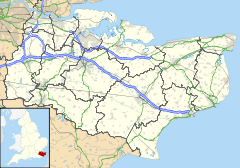Dungeness (headland)
| Dungeness | |
|---|---|
 Aerial view of Dungeness |
|
| Dungeness shown within Kent | |
| OS grid reference | TR0917 |
| Civil parish | |
| District | |
| Shire county | |
| Region | |
| Country | England |
| Sovereign state | United Kingdom |
| Post town | Romney Marsh |
| Postcode district | TN29 |
| Dialling code | 01797 |
| Police | Kent |
| Fire | Kent |
| Ambulance | South East Coast |
| EU Parliament | South East England |
| UK Parliament | |
| Website | http://www.dungeness.org.uk/ |
Dungeness (UK /ˌdʌndʒəˈnɛs/) is a headland on the coast of Kent, England, formed largely of a shingle beach in the form of a cuspate foreland. It shelters a large area of low-lying land, Romney Marsh. Dungeness is also the name of the power station, of the hamlet within the location, and of an important ecological site at the same location. It lies within the civil parish of Lydd.
The name Dungeness derives from Old Norse nes: "headland", with the first part probably connected with the nearby Denge Marsh. Popular etymology ascribes a French origin to the toponym, giving an interpretation as "dangerous nose".
Dungeness is one of the largest expanses of shingle in Europe. It is of international conservation importance for its geomorphology, plant and invertebrate communities and birdlife. This is recognised and protected mostly through its conservation designations as a national nature reserve (NNR), a Special Protection Area (SPA), a Special Area of Conservation (SAC) and part of the Site of Special Scientific Interest (SSSI) of Dungeness, Romney Marsh and Rye Bay.
...
Wikipedia

